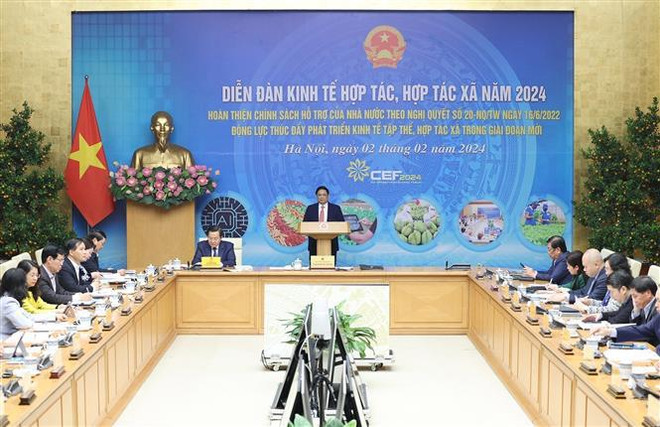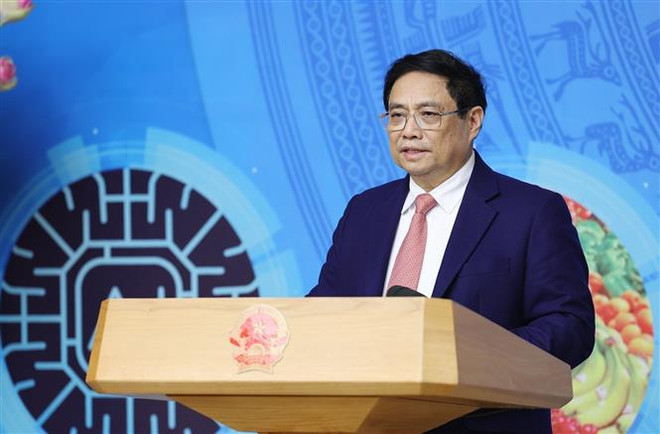 The 2024 forum on the cooperative economy and cooperatives takes place in Hanoi on February 2. (Photo: VNA)
The 2024 forum on the cooperative economy and cooperatives takes place in Hanoi on February 2. (Photo: VNA)This year’s annual forum of the Government,connected with all the 63 provinces and cities via teleconference, focused onthe perfection of the State’s support policies for the collective economy andcooperatives in line with the Party Central Committee’s Resolution No. 20-/NQ/TW,dated June 16, 2022.
PM Chinh noted that the collectiveeconomy is one of the four important economic components of thesocialist-oriented market economy of Vietnam. Over the past years, the Party,State, Government, all-level authorities, sectors, and localities have carriedout many mechanisms and policies to facilitate the collective economy andcooperatives.
At present, he said, the collectiveeconomy has basically addressed its prolonged weaknesses. Cooperatives havebasically completed the transformation to a new-style model. Cooperatives and unionsof cooperatives have increased considerably and become more diverse in terms ofindustries, scales, and levels. They have better assisted their members,created more jobs, and further improved workers’ income. The connectivity amongcooperatives and their connectivity with businesses and other economiccomponents have begun developing.
Last year, there were more than31,700 cooperatives, 158 cooperatives’ unions, and 73,000 cooperative groupsnationwide. Each cooperative earned nearly 3.6 billion VND (147,900 USD) in revenueand 366 million in profit on average in 2022, respectively rising 35% and 71%year on year. Per capita income of workers of cooperatives averaged 56 millionVND in 2022, according to the Ministry of Planning and Investment.
The collective economy andcooperatives have contributed to economic growth directly and indirectly –through impacts on their members, PM Chinh said, citing data of the GeneralStatistics Office as showing that they have contributed to nearly 4% of the country's GDP. Inmany localities like Thai Nguyen, Lam Dong, Dak Lak, Dong Thap, An Giang, andCa Mau, cooperatives have played a crucial role in the formation oflarge-scaled cash crop production zones to serve processing and export.
However, the Government leader also pointedout that their development has yet to catch up with their potential, meetrequirements, or match the attention, policies, and expectations of the Partyand State.
 PM Pham Minh Chinh addresses the forum on the cooperative economy and cooperatives in Hanoi on February 2. (Photo: VNA)
PM Pham Minh Chinh addresses the forum on the cooperative economy and cooperatives in Hanoi on February 2. (Photo: VNA)He said Resolution No. 20-NQ/TWtargets that there will be 45,000 cooperatives with 8 million members, 340cooperatives’ unions with 1,700 member cooperatives by 2030, with over 60% ofentities of the collective economy operating effectively, including at least50% involved in value chains. It also aims at over 90% of those entities operatingeffectively, including at least 75% involved in value chains, by 2045.
Requesting both quantitative andqualitative development of the collective economy, PM Chinh said it isnecessary to issue priority policies for the entities working in agriculture, linktheir production and business activities with value chains, help them applyscience - technology, boost innovation and digital transformation, and connecttheir development with the development of green economy, circular economy, andknowledge-based economy.
As Vietnam is building an independentand self-reliant economy that extensively, practically, and effectively integratesinto the world, the collective economy and cooperatives must also stayself-reliant and resilient, enhancing the connectivity among members as well asbetween the collective economy and other economic sectors, and expand cooperationwith international partners, he said.
The PM affirmed that the Governmentalways encourages and provides the best possible conditions in line with lawsfor the collective economy and cooperatives to develop fast, sustainably,inclusively, and comprehensively so as to contribute to national socio-economicdevelopment./.





























